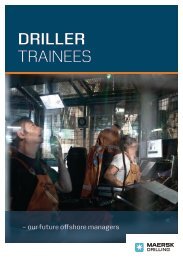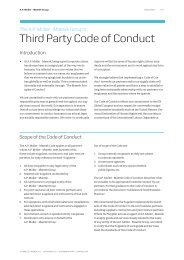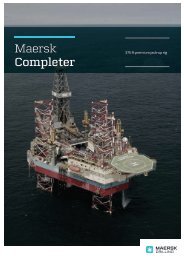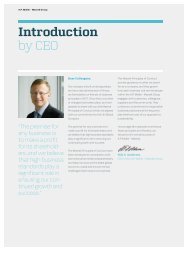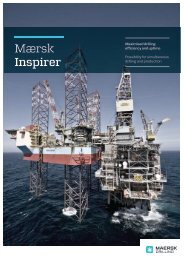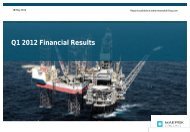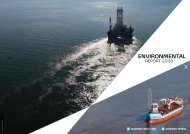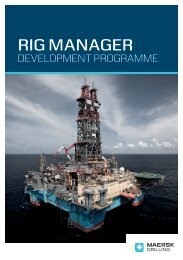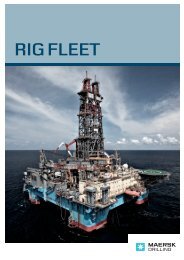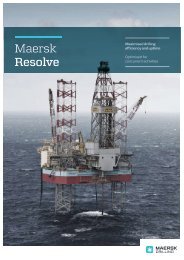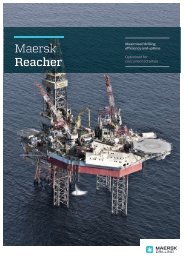Download PDF - Maersk Drilling
Download PDF - Maersk Drilling
Download PDF - Maersk Drilling
- No tags were found...
Create successful ePaper yourself
Turn your PDF publications into a flip-book with our unique Google optimized e-Paper software.
Newsletter – December 2012Newsletter – December 2012<strong>Maersk</strong> Completer has performed a 99,8%uptime in 2012.A smarter way of working isunder wayDuring 2013 – 2015 an entirely new IT landscape will be built and rolled outonshore and offshore in <strong>Maersk</strong> <strong>Drilling</strong>. The solution will address a range of painpoints and desired benefits such as removal of offshore latency and an improvedtransparency in the procurement chain.By Marlene Lyhne Sørensen, Strategy and CommunicationAfter months of extensive research andanalysis, and a careful selection and negotiationprocess, IFS Danmark A/S has beenchosen as the ERP platform most suitable toaddress the pain points and desired benefitsof <strong>Maersk</strong> <strong>Drilling</strong>.Over the next three years IFS Applicationswill be implemented in the Finance, SupplyChain & Procurement, Operations, Maintenanceand Business Intelligence processareas, amongst others replacing the SAPP3M, CODA, CMS and RFMP solutions.“One of the goals is to remove offshorelatency on all rigs. To many offshorecolleagues, the extent of latency when operatingIT systems offshore has long beena source of frustration and has negativelyinfluenced the working conditions and ourefficiency,” says <strong>Maersk</strong> <strong>Drilling</strong> CEO ClausV. Hemmingsen.Finding new ways to improve ourwork dayIFS was chosen for its attractive, intuitiveand efficient user experience, and the factthat IFS comes with substantial industryPeter Spanggard, Henrik B. Carstensen and MonsuratNurudeen in the <strong>Maersk</strong> <strong>Drilling</strong> headquarters.Preparing for the ERP landscape to take full speed.Photo: Per Gudmannexperience having successfully implementedtheir solution at other companies includingArcher and Seadrill.“The new ERP Programme is a prerequisitefor sustaining our performance and forgrowing our business in a successful manner.It is a strategic and major change managementproject which will have a profoundeffect on the way we all work in the comingyears. Processes will be removed, changedor created, just as many job contents willneed to be re-defined. This does not implya slim down of the organisation but asmarter way of working and of utilising theresources we have at hand,” says Claus V.Hemmingsen.During the implementation phase someproductivity setbacks are expected, as isalways the case when learning and adaptingto new ways of working. To make the transitionphase as smooth as possible, additionalpersonnel support will be allocated bothoffshore and onshore.“I encourage you to embrace the new ERPset-up and remember the overall target isto improve the quality and efficiency of yourwork day,” says Claus V. Hemmingsen.The first ERP phase - defining the scope - waskicked off in December. Regular informationabout the impact on working routines andupdates on the Programme’s progress willfollow.FactsERP (Enterprise ResourcePlanning) – what is it?• automates integration of dataacross an organisation with softwareapplication• facilitates information flow betweenan organisation’s businessfunctions• single point of data entry – not silosystems with redundancyAmong the desired benefitsare:• Improved usability• Optimised supply chain, includingfull visibility across rig fleet• Benchmarking, learning and optimisationacross rig fleet• Moving administration tasks fromoffshore to onshore• New finance solutions to replacecurrent outdated solutions• Improved management reportingProject overview:• Contract signed 29 October 2012• The full investment is approximatelyUSD 30 million• Organisation ~80-85 full time employees(~45 from <strong>Maersk</strong>, 30-35from IFS, ~5 external consultants)• The plan is to roll out in the HQin 2014 and to all rigs and shorebases in 2014 and 2015<strong>Maersk</strong> Completer hastaken the leadIn 2012 <strong>Maersk</strong> Completer won three awards, one of which was Shell’sprestigious 2012 Rig of the Year Award. A turnaround plan aimed at overcomingcultural differences and improving communications has led the way to success.By Marlene Lyhne Sørensen, Strategy and Communication<strong>Maersk</strong> Completer seems to be a rig on whicheverything goes right. In November 2012 itwas awarded Shell’s 2012 worldwide bestperforming Jack-up Rig of the Year Award; itwon the award for the Best Performing Unitin the <strong>Maersk</strong> <strong>Drilling</strong> fleet and on top of allthis it received the best Customer SatisfactionAward.Yet the story about <strong>Maersk</strong> Completer is notonly a story about success and high performance.As it happens, you only have to gotwo years back to experience a very differentpicture.“Two years ago, we had a number of serioussafety incidents and combined with somedrilling related problems, our peers andcustomers perceived <strong>Maersk</strong> Completerto be one of the worst performing rigs inBrunei. Something radical had to be done,”says <strong>Maersk</strong> Completer’s rig manager EddieFitzgerald.The turnaround planIn July 2010, the rig team onshore andoffshore developed and implemented acomprehensive turnaround plan which aimedto overcome cultural differences, improvecommunication and promote respect.“There was a need to examine and modifythe way the crew trusted each other, to instila change of attitude and to re-affirm theneed to lead by example from the top downand the bottom up,” explains OIM on <strong>Maersk</strong>Completer, David Reynolds.The programme was put in place in the fourthquarter of 2010, when the entire rig complementattended a three-day programme onshore.A second phase was carried out on therig in which the course facilitators, ConnectSL, continued to coach personnel by puttinginto practice what they had learnt during theonshore sessions.“The results were almost immediate; seriouslyimproved safety standards and a real upturnin performance were the best of the benefits.Additionally there was a new-found team spiritthat extended beyond the work place,” sayssafety training officer Jude Ste. Maria.“It has taken a lot of effort to get where weare today but it proves that it is indeed possibleto make a turnaround. It has definitelybeen worth it and we are very proud of ourlatest achievements. Not wanting to sit backon our successes, we will continue to focuson training and strive to sustain our strongteam spirit,” rig manager Eddie Fitzgeraldadds.4 <strong>Maersk</strong> <strong>Drilling</strong><strong>Maersk</strong> <strong>Drilling</strong>5
Theme: Taking training to the next levelNewsletter – December 2012 Newsletter – December 2012Theme: Taking training to the next levelTraining takes a stepcloser towards realityThe Macondo accident revealed a need for team-based well-control training, and<strong>Maersk</strong> <strong>Drilling</strong> has once again put itself in the forefront by investing USD 10 millionin a new drilling simulator complex. “We now have the opportunity to take trainingto the next level,” says Allan McColl, a member of the <strong>Maersk</strong> <strong>Drilling</strong> Post-Macondointernal task force.By Marlene Lyhne Sørensen, Strategy and CommunicationIf everyone had been assured in their roleand been comfortable enough to speak upbefore the well went out of control, the fireand explosion on Deepwater Horizon in 2010might have been avoided. The catastropheled to 11 lost lives and was a major blow tothe environment and to the reputation of thedrilling industry.“Many factors were at play when the accidenthappened, but it seems evident thatthe competency level and the lack of goodteamwork and clear communication was partof the problem,” says Allan McColl, head of<strong>Drilling</strong> Support and member of the MD Post-Macondo task force.The new state of the art training facilities at <strong>Maersk</strong> Training in Svendborg will be in highdemand as <strong>Maersk</strong> <strong>Drilling</strong> is in the process of hiring 3,000 new employees and doubling itsfleet.Photo: Ricky John MolloyThe new drilling simulator features thelatest 3D technology and rig specificdesigns to mirror the exact workingconditions on the rigs.Photo: Ricky John MolloyAlthough <strong>Maersk</strong> <strong>Drilling</strong> was not involvedin the Macondo accident, CEO Claus V.Hemmingsen established a task force todetermine how to prevent such catastrophesand a newly inaugurated drilling simulatorcomplex is a very visible outcome of thiswork.“Of the many investigations looking into theaccident, lack of well control has been recognisedto be a core element, and this clearlycalls for an intensification of the manner inwhich we view training,” says Claus Bachman,head of the Post-Macondo task force.No time to waitThe task force’s initial findings and a commitmentto be in the forefront of trainingto ensure safe and efficient operations ledto <strong>Maersk</strong> <strong>Drilling</strong>’s decision to invest USD10 million in the new state of the art drillingsimulator complex. The simulator is locatedat <strong>Maersk</strong> Training in Svendborg, Denmarkand was inaugurated in late October.“The simulator has been designed specificallywith team-based training in mind. The industryis still formulating a new training standardthat can fulfil the need for such qualifications,but we have decided that we don’t want towait for a standard to be finalised before wereact,” Claus Bachman says.A classroom is too far fromrealityThe aim has been to develop a training coursethat is as realistic as possible. The testingof individuals seated in classrooms simplydoesn’t take into account the range of skillsrequired in real-life well control incidents,Allan McColl points out.“In real life you have to communicate and actacross several barriers, be vigilant for equipmentmalfunction and anomalies in the wellbehaviour. Theoretical training and testingcannot take all these elements into account,”says Allan McColl.Another important opportunity within thetraining facility is that it can involve thecompany man.“The customer representative will alwaysplay the central part in a well control scenarioshould it arise in real life, so this is a veryimportant feature. I think the new drillingsimulator complex presents a seriouscommitment to effective training when weexceed any known industry requirement. Andto be honest, I think we can be very proud ofthe opportunity we have created and commitmentwe have demonstrated,” says AllanMcColl.FACTSThe Macondo accident:On 20 April 2010 a fire and explosion occurred on board the deepwater semisubmersibledrilling rig, Deepwater Horizon, leading to 11 lost lives and massiveenvironmental damage. The deepwater drilling rig was working on BP’s Macondofield at 5,000 ft of water, 41 miles offshore Louisiana in the Gulf of Mexico. Twodays later the rig sank.Investigations are still ongoing as to what caused the accident.The <strong>Drilling</strong> Simulator Complex:The new simulator has been designed to provide the following:• Training beyond the standard IWCF internationally recognised well control course.• Training that can be conducted in teams, i.e. to include the positions on the rig thatwould normally respond to a well control incident (the senior tool pusher, toolpusher,driller, asst. driller).• Rig specific training in which, for the CJ 70s, DSS 21 deepwater semis and the newdrillships, the simulator directly mirrors the drill floor layout and controls on theparticular rig.Looking Forwards:• Future plans include adding training for MPD (Managed Pressure <strong>Drilling</strong>) and forDWOS (<strong>Drilling</strong> of a Well on Simulator).• A marine simulator will allow for training in dynamic positioning and control of stability.Ultimately there will also be an engine room power generation simulator and acrane simulator. When all are in place, management of major emergency training canbe conducted where all rig departments will combine in response to realistic majorscenarios, such as a well control incident in combination with a loss of power.6 <strong>Maersk</strong> <strong>Drilling</strong> <strong>Maersk</strong> <strong>Drilling</strong> 7
Theme: Taking training to the next levelNewsletter – December 2012 Newsletter – December 2012Theme: Taking training to the next level“Phew, I’m glad to get outof there”Teamwork, clear communication and making mistakes are key elements whentraining in the new drilling simulator complex at <strong>Maersk</strong> Training in Svendborg.By Marlene Lyhne Sørensen, Strategy and Communication.The phone rings in the Mud Logger’s Shack.The mud logger picks it up.“Hello?”“Hello, this is the Driller’s Cabin. We have aproblem with the well. I need the exact depthof the casing.”“What are you saying? You need the exact,what … I don’t understand,” says the mud logger,speaking with a heavy accent.The driller calling from the Driller’s Cabin isholding the phone in one hand and looks as ifhe is about to take a deep breath.“I need the exact depth of the casing. Now,please,” says the driller.The mud logger finally understands and giveshim the requested information.“But, but how is your mother?” he asks.“I don’t have time to talk,” the driller replies,and hangs up.The well from hellDariuz Koziel, his colleague Michael Bach andthe BP representative from <strong>Maersk</strong> Reacher,Kjetil Vadset, have been inside the Driller’sCabin for more than an hour struggling tosolve severe problems with the well. The ‘wellfrom hell’, they call it.Fortunately the situation is not taking placeon a rig in operation, but in <strong>Maersk</strong> <strong>Drilling</strong>’snew drilling simulator complex located at the<strong>Maersk</strong> Training in Svendborg, Denmark. Themud logger is played by one of the instructors,Kim Yding Noe, and he is not sitting inthe Mud Logger’s Shack, but in the Instructor’sRoom right next to the Driller’s Cabinsimulator.On a rig the driller can call 10-15 differentpeople for assistance or information. Allthese lines of communication are intact inthe drilling simulator complex, but the manydifferent people representing different functionson a rig are all played by an instructor.Teamwork is a prerequisiteThe new simulator complex is the first of itskind. It is designed for team-based training,and thus it offers a framework to strengthenthe interaction between crew members invarious functions on the rig.“The most advanced drilling equipmentbecomes useless if the crew cannot worktogether, and the best driller in the worldturns out to be the worst if he cannot communicate,”says Tonny Møller, operationsmanager at <strong>Maersk</strong> Training.The new simulator complex offers a nearreal-life environment through use of the specificdesigns of <strong>Maersk</strong> <strong>Drilling</strong>’s rigs, and itprovides the possibility of linking the Driller’sCabin, the central control room, the craneoperator and the engine room together toprovide a more comprehensive well-controlscenario.“If the going gets tough on a rig, the driller,the crane operator, the OIM and several otherfunctions have to overcome the problems ina joint effort. The same goes for this simulatorcomplex,” Tonny Møller says.When the session in the Driller’s Cabin is over,the <strong>Maersk</strong> Reacher crew members and theinstructors will give their feedback to the drillcrew. The point is to get to know each other’sstrengths and weaknesses and becomeaware of the performance potential, whenthe crew works together as a team.“We make an effort to point out mistakes,not to victimise anyone, but to become awareand take the opportunity to improve ourselvesand correct any unfortunate behaviouras a measure to increase the competencylevel should a similar well-control scenarioarise offshore,” explains Tonny Møller.Session over“Start pumping, start pumping,” Dariuz criesinside the Driller’s Cabin.A few minutes later Dariuz, Michael and Kjetilseem to have reached a solution which willat least prevent a further escalation of thesituation.“It is not the most beautiful solution, but it is asolution,” concludes instructor Kim Noe, whopreviously worked as lead driller on MærskInspirer and <strong>Maersk</strong> Guardian.He picks up the phone and calls the Driller’sCabin.“The session is over. You can come out,” heexclaims.No time for small talk“Phew, I’m glad to get out of there,” Kjetil Vadsetsays when he reaches the coffee area inthe reddish-brown brick building that housesthe drilling simulator complex.“It was stressful,” agrees Dariuz, before hegrabs a cup of coffee.The senior tool pusher Jesper V. Pedersen wasin the simulator on a previous session thatday.“It is not the real deal, but it is as close as itgets,” he says.“I like the set-up of the course. It takes thehuman factor into serious consideration,and it is OK to make mistakes. Actually themistakes are a very important part of thelearning process,” he adds.“Yes, this is much more effective than justsitting in a classroom reading a book. Ibecome aware of my mistakes and I try toimprove myself. Yesterday, I learnt that I wasbeing too polite and talkative. There’s no timefor that. Today, I was much more focused ongetting the job done. Even when the mud loggerasked me about my mother,” says Dariuz.The ‘well from hell’ scenario cannot be revealedin detail, because it might be includedin future training sessions.On a rig the driller can call 10-15 differentpeople for assistance or information. Allthese lines of communication are intact inthe drilling simulator complex.Photo: Ricky John MolloyOK to make mistakesAt present, the Driller’s Cabin is only linked upto the instructor room next door.Dariuz has returned to the driller’s chair afterhaving passed the exact depth of the casingto Kjetil Vadset from BP.Dariuz is back in the driller’s chair with a firmgrip around the drilling joy stick. Kjetil Vadsetis standing in the corner calculating thepressures with which he needs to controlthe well to avoid further problems, and in theopposite corner is Michael, apparently notdoing anything.The human factor plays an importantrole in the new course set up. Just as itdoes in real life.Photo: Ricky John MolloyIn the Instructor’s Room next door, leaddriller Martin Bülow and two <strong>Maersk</strong> Traininginstructors observe the situation on threescreens linked up to cameras in the Driller’sCabin.“Why don’t they involve Michael? He can doall the calculations. He is excellent at crushingnumbers,” says Martin Bülow, and notesdown his observation.The mud logger is played by Kim Yding Noe, one of theinstructors sitting in the Instructor’s Room next tothe Driller’s Cabin simulator. The driller crew is beingvideo recorded and can be followed on screens in theInstructor’s Room.Photo: Ricky John Molloy8 <strong>Maersk</strong> <strong>Drilling</strong> <strong>Maersk</strong> <strong>Drilling</strong> 9
Theme: Taking training to the next levelNewsletter – December 2012 Newsletter – December 2012Theme: Taking training to the next levelMærsk Delivereris creating win-winin AngolaMærsk Deliverer’s performance is flying high in Angola. However, theoperation is by no means a walk in the park. A total of 70% of the crew is requiredto be Angolan, and local skills are low. “We want it to be a win-win situation,” saysJens C. Rise, rig manager on Mærsk Deliverer.By Marlene Lyhne Sørensen, Strategy and CommunicationWhen the OIM on Mærsk Deliverer sharedthe news at the end of the morning meeting,some of the Angolans stood up and clappedtheir hands. They had just been offered theprospect of health care insurance, not justfor them but also for their wife and children,within a few months.“Angola is one of Africa’s leading oil producers,but most people still live on less thanUSD 1 a day. If you drive through certain areasof Luanda, you’ll get an idea of what healthcare insurance can do for a family,” says JensC. Rise, rig manager on Mærsk Deliverer, whichstarted operations in Angola in May 2012.Angola is believed to have one of the largestdeepwater oil reserves in the world, andwith Mærsk Deliverer <strong>Maersk</strong> <strong>Drilling</strong> hasentered Angolan waters for the first time,although probably not the last given that theWest African country has been selected asa strategic area of interest for growing thebusiness.Looking for the right attitudeAlthough Mærsk Deliverer has hit the groundrunning in terms of performance, there areconsiderable challenges along the way; themost substantial one being the Angolan authority’slocal content requirements implyingthat 70% of the rig crew has to be local employeeswithin a few years after start-up inAngola. So far 35-40% of the Mærsk Deliverercrew are locals hired through an agency andin November <strong>Maersk</strong> <strong>Drilling</strong> signed the firstpermanent contract with an Angolan.“The education level is generally low, so thereis not a great pool of qualified candidates inthe local work force. We pick the people withthe right attitude, and invest in them withtraining, career planning and an attractivebenefits package,” says Jens C. Rise.So far not all have had the attitude that therig management is searching for.The Mærsk Deliverer regularly has more thantwenty nationalities on board and the crewhas many years of experience in dealing withdifferent cultures and mindsets.Onboard training is kicking inOnboard training and vast experience in dealing with different cultures is payingoff on Mærsk Deliverer in Angola.By Marlene Lyhne Sørensen, Strategy and CommunicationCrew taking a break on Mærsk Deliverer.“We have sent many home and some havebecome quite upset. That’s the way it is. Weare in Angola for the long term, and we wantto invest in people with a clear potential,”explains Jens C. Rise.Creating a win-win situationNumerous locals have now been offereda long-term contract to stay with <strong>Maersk</strong><strong>Drilling</strong>. To become directly employed by<strong>Maersk</strong> <strong>Drilling</strong> will not only give them higherearnings, they will also be offered career planningand other benefits such as health careinsurance for themselves and their families.“We want to spend a lot of resources indeveloping a competent and high-performingcrew, while providing better living conditionsfor the locals. We want our activities inAngola to create a win-win situation,” saysJens C. Rise.Keep it friendly, keep it firm and try to havesome fun. According to barge engineerMichael Sutherland those are the key wordswhen establishing a new crew and this alsogoes for Mærsk Deliverer in Angola where 35-40% of the crew consists of locals.“We find that as in any culture, there is areluctance to admit to not knowing or notunderstanding, and we as the team onDeliverer have to build up that confidencein the new crew every time so that they cancome to us without any apprehension andask questions. But this is not easy with alanguage and cultural barrier,” says MichaelSutherland.To help out there are two Portuguesespeakinginterpreters onboard and allsafety officers are fully bilingual. Even moreimportant is that the crew has many years ofexperience in dealing with different culturesand mindsets, says rig manager Jens C. Rise.“An inclination to know about other culturesand a general respect for the locals are importantprerequisites to overcome the culturalbarriers,” he adds.SAP planner John Kemp is one of the crewmembers with many years of experience inthis regard:“We regularly have more than twentynationalities on board, so there has alwaysbeen the challenge of language and culturaldifferences. There are also some locals whoare reasonably bilingual so it is often possibleto distribute them amongst the crews toovercome any communication problems onthe spot,” says SAP planner John Kemp.Training onboardAll locals go through training to ensure a sufficientcompetency level, but due to a scarcityin training facilities onshore, and the factthat Angolans generally have a low chance ofobtaining visas to other countries, most ofthe training and certification of the local crewtakes place on the rig.Certification is still a challenge, but with thehelp of HR ashore and the use of Falck Nutectrainers on board for the last two months, thelocals’ training efforts seem to be paying off.“I think their hard work and <strong>Maersk</strong> <strong>Drilling</strong>’scommitment to training is coming throughnow,” says Michael Sutherland.10 <strong>Maersk</strong> <strong>Drilling</strong> <strong>Maersk</strong> <strong>Drilling</strong> 11
Theme: Taking training to the next level Newsletter – December 2012Newsletter – December 2012In the business to staySimao Miguel is one of the local Angolans working on Mærsk Deliverer. Thecolleagues and team spirit onboard, as well as the opportunity to improve livingconditions, are the biggest assets of his job, he says.By Marlene Lyhne Sørensen, Strategy and CommunicationThe first time Simao Miguel heard about<strong>Maersk</strong> <strong>Drilling</strong> was in a job advertisement inan Angolan newspaper. <strong>Maersk</strong> <strong>Drilling</strong> wasa newcomer to Angola looking for local crewand Simao Miguel decided to apply for thejob. He had worked for several oil companiesin Angola, where the oil industry is picking uppace, and he liked the international environmentand the opportunity to use and furtherstrengthen his English skills.You can always ask for helpHe was called in for interviews and a fewweeks later he was on his way to MærskDeliverer, which commenced a two-yearcontract with Chevron in Angola in May 2012.The rig hit the ground running, and after onlyone month in operation it was awarded as‘Super Rig of the Month’ out of the six rigs theoil company operates in Angola.“So far it has been a wonderful experience.I meet very good people and I feel freeto express myself. If I have a problem orwhen there is something I don’t know, I feelcomfortable asking for help. Basically thereis a very positive atmosphere. Working inthis crew you get a feeling that we are allequal,” says Simao Miguel, who is workingas rig administrator handling crew changes,communication with shore base and otheradministrative tasks.Improving living conditionsSimao Miguel can see himself continuing towork in the oil industry for many years.“The oil industry is growing in Angola andit is an opportunity for many Angolans toimprove their living conditions. I feel quitepositive about my future and hope for manygood years in this field,” says Simao Miguel.“I feel quite positive about my future andhope for many good years in this field,”says Simao Miguel rig administrator onMærsk Deliverer.Engaged employeesdemand good leadersEffective leaders are essential to employee engagement and customer satisfaction,and over the past few years <strong>Maersk</strong> <strong>Drilling</strong> has increased its focus on leadershiptraining. The result of the 2012 Employee Engagement Survey was at an all-time high.By Marlene Lyhne Sørensen, Strategy and CommunicationGood leadership is the number one reasonfor engaged and high performing employees.Actually the most common reason for peoplequitting their job is that they are unhappywith their boss.“To put it simply, a good leader createsengaged employees and engaged employeesperform better, which leads to satisfiedcustomers,” says Erik Roesen Larsen, TrainingManager in <strong>Maersk</strong> <strong>Drilling</strong>.Since 2010 <strong>Maersk</strong> <strong>Drilling</strong> has stepped upits leadership training, and by year-end 2012around 50% of all onshore and offshore leaderswill have been through leadership trainingcourses tailored for the drilling industry.“Our ambition is to have the best leaders inthe industry and we measure this throughthe Employee Engagement Survey. It is theemployees who evaluate our leaders,” saysErik Roesen Larsen.When the result of the annual EmployeeEngagement Survey came out in October, itrevealed an all-time high engagement scoreof 83% for onshore employees and 77% foroffshore employees.“I think it is a good indication that ourleaders are doing a good job and this isnot only important for high performanceand retention purposes, it is also veryimportant in terms of delivering high qualityand efficiency to our customers,” says ErikRoesen Larsen.“Actually we can see that leadership mattersmore to customer satisfaction in <strong>Maersk</strong><strong>Drilling</strong> than in other <strong>Maersk</strong> business units,because of the very close relationship betweenthe crew and the customer on the rig.If there is bad leadership, the crew becomesdisengaged, performance starts to suffer –and so does the customer satisfaction,” headds.The leadership training efforts will continueas <strong>Maersk</strong> <strong>Drilling</strong> grows.“I believe training and developing good leaderswill become increasingly important,” saysErik Roesen Larsen.Can anybody become a good leader throughtraining?“Some have a greater potential than others.But I think almost anyone can become abetter leader through the tailored trainingcourses, because they raise awarenessof how to lead and provide some tools forimprovement,” says Erik Roesen Larsen.In 2012 <strong>Maersk</strong> <strong>Drilling</strong> spent about USD 1million on leadership training. The duration ofthe tailored courses vary from one-and-a-halfdays to four days.What makes a good leader?Scott Mooney,Roughneck on <strong>Maersk</strong> Guardian“A good leader is someone who is approachable.It is important that the leader is someonewho gets along with the crew and whocan speak to them on a personal level as well.It is someone you can respect.A good leader praises good results. If you letpeople know that they are doing a good job,if they are being encouraged, you will actuallyget the best out of people. On the otherhand, if a leader only hits on the negativethings it affects your confidence and yourperformance.Bo Christensen,Driller on <strong>Maersk</strong> Guardian“A good leader is someone you haveconfidence in. It is a person with technicalknow-how and who is able to communicatethis know-how in a way so everybodyunderstands. A good leader also has asense of humour. Our environment is tightlyregulated with procedures that always needto be followed; it makes you quite restrained– which is the way it should be in order tohave a strong safety culture – but it is goodto have a leader who reminds you that weare also supposed to have fun at work. A badleader with no sense of humour can take asingle walk across the drill floor and ruin anotherwise positive spirit. Usually non-verbalcommunication is the worst. It makes youself-conscious – are we doing somethingwrong? I think it increases the risk of makingmistakes.A good leader is also conscious about his orher responsibility towards developing people.Bo Christensen gives his advice on whatmakes a good leader.If a crew member has washed the deck forfour years, they might need some new challenges.Otherwise it is likely they will go andlook for another job or another company.”12 <strong>Maersk</strong> <strong>Drilling</strong><strong>Maersk</strong> <strong>Drilling</strong>13
Newsletter – December 2012Newsletter December 2012Newsletter – December 2012“I am the guy breathingdown their necks”The second of four newbuild drillships is now on contract, reconfirming theoil companies’ appetite for ultra-deepwater drilling. Gunnar Bjornsson plays a vitalrole in getting the ships ready on time. Otherwise it could mean a loss of revenue ofabout USD 550,000 a day.By Marlene Lyhne Sørensen, Strategy and CommunicationGunnar Bjornsson does not look like a manunder pressure as he looks up from his deskwith a solid and calm expression in his eyes,but the responsibility resting on his shouldersis immense.Within the next two years he needs toensure that four new drillships are finishedat Samsung Heavy Industries in South Koreaand handed over to the oil companies eagerto expand their activities in ultra-deepwaterdrilling. The first two ships – the second wassecured a contract in October - will be finalisedin late 2013 and have been settled at aday rate close to USD 550,000 – so delays arenot an option.“We closely monitor the building process.The contractors and subcontractors at theyard are under a lot of pressure to live up totheir promises due to the high demand fornewbuildings, and I’m one of the ship ownerrepresentatives breathing down their necksto keep them focused on the project whilemaintaining an open dialogue,” says GunnarBjornsson.He is sitting in his office at the <strong>Maersk</strong> <strong>Drilling</strong>headquarters in Lyngby, Denmark, which isnot a regular occurrence. Very frequently hetravels to the yard in South Korea to followthe building of the drillships at close hand andto make sure everything is on track.“It is quite intense. For example, during thedesign phase we received feedback from thecustomers which meant we had to increasethe mud capacity on all drillships. We hadto rush to Korea for face-to-face meetingsbetween the project team and the yard toevaluate the design options and decide onthe best option in order to minimise cost andtime impact.”He smiles wryly: “I know how it is to be in theyard team’s shoes.”Attracted by complexityShipbuilding has played a major role in GunnarBjornsson’s professional life. After 14 years ofsailing and exploring the world, he trained asa naval architect, and in 1990 he was hired atthe Danish B&W Shipyard, the shipyard thatbuilt the first oceangoing diesel vessel.“Things were really jumping at the B&Wshipyard back in the nineties, and I had a greattime. We built about five ships a year, and I metmany ship owners during that time keeping aneye on the projects and anxious to speed upthe process,” says Gunnar Bjornsson.Later when joining <strong>Maersk</strong> Ship Design, GunnarBjornsson was enrolled in the building ofnew LNG ships at Samsung Heavy Industriesin South Korea. It was at this point he discoveredthe drillships as a potential new area ofinterest.“I was attracted by the complexity. I have builtmany ships, but a ship with a drilling componentwas something new and exciting, and tobecome the project manager of the four drillshipsnow being built for <strong>Maersk</strong> <strong>Drilling</strong> wassomewhat of a dream position,” says GunnarBjornsson, the project manager since 2011.The big test still lies aheadSo far things are going well. The big test of thebuilding process will be the commissioning ofthe drillships at the end of the constructionphase.At this point all systems will be tested tomake sure everything is okay before thecustomer takes it on contract.First and foremost Gunnar Bjornsson islooking forward to stepping onboard the firstdrillship.“I am sure it is going to feel very good to finallybe onboard and witness the result of a longtermteam effort,” he says.“I have built many ships, but a ship with adrilling component was something newand exciting,” says Gunnar Bjornsson,project leader of the drillships underconstruction.FactsThe four ordered drillships beingbuilt in South Korea will be capable ofdrilling wells of 40,000 ft (12,200 m).The drillships are scheduled fordelivery in 2013 and 2014, and thetotal project cost is close to USD 2.6billion. The first two drillships aregoing to the U.S. Gulf of Mexico, anarea with great ultra-deepwater oiland gas resources.Five quick questions forSøren Risgaard Jeppesen– about Dropped ObjectsBy Marlene Lyhne Sørensen, Strategy and Communication01Why have you decided to establish a DroppedObjects Task Force?When we view our HSE statistics over the past few years,Dropped Objects (DOs) are by far the biggest challenge. Theseriousness of this matter is shared throughout the industry,treating dropped objects as a separate and highly prioritisedfocus area in order to create a safer working environment.The first step for Operations Management to turn this challengearound was to launch the Drops Awareness campaignin 2011, and the Dropped Object Task Force (DOTF) is seen asthe follow-up in order to capture the lessons learnt from thecampaign.02What will the Task Force do to improve safety?DOs are a field of great complexity which can make one feel thatthey are not in control. The Dropped Objects Task Force aims toprovide the structure and support to take that control.Improving the quality and the range of the inspection manualsis one important step. Some rigs have hired third-party companiesto make this improvement, however this includes far fromall rigs. And our statistics show that 74% of all DOs could havebeen addressed by carrying out structured inspections.03What about the remaining 26%?The Task Force is working on a programme consisting of fiveseparate but interacting initiatives. Some of these are generic,while others will be more rig-specific. The basic idea is thatsome rigs are already doing an outstanding job on DOs and thatthis effort should not be hindered. On the other hand, other rigsneed a little more help and the initiatives will give these rigsmore of a framework to work from.The five initiatives are:1. Alignment and values documentDefines the <strong>Maersk</strong> <strong>Drilling</strong> approach to working withdropped objects.Everyday objects when working offshore can turn into lethal weapons whendropped. <strong>Maersk</strong> <strong>Drilling</strong> has established a Dropped Objects Task Force to fightand minimise the risk. Which tools are they going to apply? Søren RisgaardJeppesen, director in HSE Operations, answers five quick questions.2. One Stop Drop CatalogueA series of documents, generic processes and unit-specificguides addressing the onboard hazard hunt.3. Tailored Dropped Object ProfileThe opportunity for unit-specific analysis to take workprocesses, work areas and equipment into considerationwhen determining what characterises the rig’s primary DOchallenges.4. Dropped Object Culture Track/ToolboxTools to maintain focus on safety and dropped objects andresist complacency. We want to reach a position wherethe mindset is changed from “we haven’t had an incident,we are doing so well” to a philosophy of “we haven’t had anincident, what are we overlooking and what else do we needto do?”5. Drops TransparencyKnowledge sharing of the 5+5 workshops that were heldoffshore last year. A number of valuable suggestions on howto avoid DOs were shared and these are now being brokendown into a number of different initiatives. A platform willbe developed to host these initiatives. Some of them will be“Ready to Run”, while others will include a cost.04Why have you chosen these initiatives?The inspiration comes from many different sources, such asexperiences and best practices from rigs that have succeededin turning around a difficult drops trend. Another importantsource has come from dialogue with other stakeholders suchas clients, HSE coordinators and HSE coaches.05When will the initiatives be rolled out to the fleet?Our aim is to have the programme ready by the beginning of2013. It will be designed to work through “pick and mix” and willbe rolled out upon request from the rig and/or the rig team. It includesindividual analysis and tools to finding potential droppedobjects and a structured approach to avoiding the resultingincidents. Focus will thus be on the specific initiatives that canbring the most value to the rig’s work with preventing droppedobjects.14 <strong>Maersk</strong> <strong>Drilling</strong><strong>Maersk</strong><strong>Maersk</strong><strong>Drilling</strong><strong>Drilling</strong>15
SAFETYNewsletter – December 2012 Newsletter – December 2012SAFETYSafety performanceon a downward pathNew SIRIUSlook and feelBy Wouter van Doesum, QM/HSE<strong>Maersk</strong> <strong>Drilling</strong> is currently performing below the industrial average interms of safety. Studies are being conducted to identify the factorsaffecting the incidents and prompt actions are being taken based onthese findings.Five lost time incidents (LTIs) and 12 total recordable cases (TRCs)occurred in <strong>Maersk</strong> <strong>Drilling</strong> in Q3 2012. This brought the YTD LTI frequencyby September 2012 to 1.34; the YTD TRC frequency was 4.46by September 2012. For comparison the YTD IADC benchmarking is0.99 for LTI frequency and 3.37 for IADC YTD TRC frequency.MD overall safety performanceLTIs and LTI Frequency (incl. Administration) 12 Months Rolling Trend1,405Safety Performance per offshore locationFrequencies of Last 12 Months302724211815129630<strong>Maersk</strong> Completer<strong>Maersk</strong> ConvincerNo. of MTCNo. of RWCNo. of LTINo. of FTLLTIF last 12 monthsTRCF last 12 monthsMærsk Giant<strong>Maersk</strong> Pioneer<strong>Maersk</strong> Rig 42<strong>Maersk</strong> Rig 62Mærsk DeveloperHeydar AliyevMærsk Innovator<strong>Maersk</strong> Reacher<strong>Maersk</strong> Resolute<strong>Maersk</strong> Resolve<strong>Maersk</strong> Rig 41<strong>Maersk</strong> Rig 44NanHai VI<strong>Maersk</strong> Guardian<strong>Maersk</strong> Pathfinder<strong>Maersk</strong> Rig 61<strong>Maersk</strong> Rig 52Mærsk Deliverer<strong>Maersk</strong> Resilient<strong>Maersk</strong> DiscovererMærsk Gallant<strong>Maersk</strong> Endurer<strong>Maersk</strong> Rig 12<strong>Maersk</strong> Rig 455,04,54,03,53,02,52,01,51,00,50,0No.of Serious Personal Injuries of YTD by Last Month (Sep 2012)Personal injuries occurred in Q3 2012Head & Face25 %, 12 injuriesNeck0 %, 0 injuriesArm/Shoulder/Elbow19 %, 9 injuriesHand/Finger/Wrist27 %, 13 injuriesBack2 %, 1 injuriesFront & Side Trunk4 %, 2 injuriesLeg13 %, 6 injuriesAnkle & Foot10 %, 5 injuriesWork Activities involved Hand/Finger/Wrist injuriesMaintenance and technical modifications (five) and drilling/wellactivities (three) covered more than half of the total work activitiesinvolving Hand/Finger/Wrist injuries.With SIRIUS fully implemented, surveysshow that the user interface toSIRIUS is complex and difficult to use.Improvements will be made to ensureusers feel comfortable using it.A radical improvement of the SIRIUS interface will now be installedto increase usage of and compliance with SIRIUS. This will ultimatelyhave a positive impact on safety and efficiency.“We have worked closely with offshore users to ensure that thenew user interface is simple and easy to use offshore,” explainsHenrik Holde, Head of Business Process Improvement.LTI Frequency1,201,000,800,600,400,200,01.341.051.17 1.150.830.970.920.930.720.710.480.49 0.490.470.590.37 0.370.360.470.400.370.300.240.00oct-11 nov-11 dec-11 jan-12 feb-12 mar-12 apr-12 may-12 jun-12 jul-12 aug-12 sep-1243210No.of LTIs as per MonthThe chart above shows the safety performance of MD by 2012 YTDwith last 12 months rolling frequency of LTI and TRC. <strong>Maersk</strong> Discovererhas the highest record (two) while <strong>Maersk</strong> Rig 45 has the highestfrequency (5.95) of LTI for the last 12 months.Work activities involved in Actual DROPs during Last Quarter8 %8 %MAINTENANCE AND TECHNICAL MODIFICATIONS, 538 %DRILLING/WELL ACTIVITIES, 38 %CATERING, 2The new interface looks like Wikipedia and is built around the simpleprinciples of intuitive design, less clicking and a search functionthat works like Google.Positive feedbackSeveral rigs have been involved in the design and their feedback ispositive:oct-11 nov-11 dec-11 jan-12 feb-12 mar-12 apr-12 may-12 jun-12 jul-12 aug-12 sep-120 1 0 0 1 0 2 0 1 1 2 20.30 0.40 0.37 0.00 0.72 0.47 1.05 0.83 0.92 0.97 1.17 1.340.49 0.49 0.37 0.37 0.36 0.24 0.48 0.47 0.59 0.71 0.93 1.15Top 5 HSE Awards issued during Q3 2012Days withoutany RecordableDate ofUnit HSE Incidents HSE Award15 %23 %CRANE- AND LIFTING OPERATIONS, 1MARINE OPERATIONS, 1OTHER PROCESS, 1“I am finding the content that I am searching for, and I also find allthe documents related to that operation. This is an improvementcompared to the former SIRIUS”“The index/search system is easy to use and does the job”TRCs and TRC Frequency (incl. Administration) 12 Months Rolling TrendTRC Frequency10209188167145.6961254.474.46 104.344.19 4.15 4.154.19483.103.284.472.953.084.12 4.173.80 3.803.68363.403.313.243.083.07 3.21241200oct-11 nov-11 dec-11 jan-12 feb-12 mar-12 apr-12 may-12 jun-12 jul-12 aug-12 sep-12oct-11 nov-11 dec-11 jan-12 feb-12 mar-12 apr-12 may-12 jun-12 jul-12 aug-12 sep-124 3 2 4 2 1 5 3 3 5 2 52.95 3.10 3.08 5.69 4.34 3.28 4.19 4.15 4.15 4.47 4.19 4.463.07 3.21 3.08 3.31 3.40 3.24 3.68 3.80 3.80 4.12 4.17 4.47No.of TRCs as per MonthMAERSK CONVINCER 360 05/07/12MAERSK COMPLETER 270 26/08/12NAN HAI VI 180 09/07/12MAERSK DISCOVERER 90 21/07/12MAERSK EXPLORER 90 26/07/12Top 3 Safety awards issued for Venezuela barges during Q3 2012DaysDate ofUnit without any LTIs Safety AwardMAERSK RIG 42 2,340 20/07/12MAERSK RIG 41 2,340 16/08/12MAERSK RIG 52 900 13/09/12Potential and *Actual DROP’s which occurred during Q3 2012Numbers of Potenal and Actual DROPs YTD 20123001250142003416715000111001215000 0 0 0 0 0 0 0 0 00<strong>Maersk</strong> Rig 42<strong>Maersk</strong> Rig 45<strong>Maersk</strong> Rig 62<strong>Maersk</strong> Pathfinder<strong>Maersk</strong> Rig 12<strong>Maersk</strong> Rig 52<strong>Maersk</strong> Rig 41<strong>Maersk</strong> Rig 44<strong>Maersk</strong> Rig 61<strong>Maersk</strong> PioneerMærsk Developer<strong>Maersk</strong> Convincer<strong>Maersk</strong> CompleterNanHai VIMærsk InnovatorMærsk GallantMærsk Giant<strong>Maersk</strong> EndurerHeydar Aliyev<strong>Maersk</strong> Reacher<strong>Maersk</strong> ResolveMærsk Deliverer<strong>Maersk</strong> Discoverer<strong>Maersk</strong> Guardian<strong>Maersk</strong> Resolute<strong>Maersk</strong> Resilient14.0012.0010.008.006.004.002.000.00Frequency of Actual DROPs Over 40J of last 12 months“It’s like searching the internet. A very user-friendly and time-savinginterface”“This is very good! Now people can easily find procedures andinformation in SIRIUS”Less time spent on navigatingChanging the portal does not change any processes or proceduresin the SIRIUS management system.“The quality and robustness of the management system stay thesame, but users will immediately feel at home in the new portalwhich will enable them to focus more on procedures and less onnavigating the system,” Henrik ends.The new portal will be available in early 2013 across the fleet.The chart above shows dropped object incidents in 2012 YTD with 12months rolling frequency of DROPs > 40J. <strong>Maersk</strong> Resilient has thehighest record (seven) of DROPs over 40J and the highest number ofDROPs (11) less than 40J. <strong>Maersk</strong> Resolute is the second highest.16 <strong>Maersk</strong> <strong>Drilling</strong><strong>Maersk</strong> <strong>Drilling</strong>17
EnvironmentNewsletter – December 2012Newsletter – December 2012MARKET INSIDEExternal spills show adecreasing trend<strong>Maersk</strong> <strong>Drilling</strong> has a strong focus on the environment and has conducted an indepthanalysis on spills and how to improve the performance of the fleet. <strong>Maersk</strong> <strong>Drilling</strong>is committed to using technologically advanced and environmentally protective materialsand equipment.<strong>Maersk</strong> <strong>Drilling</strong> performs daily quality checks of incident reports withregards to external spills/discharges as well as accidental spills/discharges contained on board. During the past 12 months we havehad a number of spills, including oily products spills, chemical spillsand drilling fluid spills; however by August 2012 the total number ofexternal spills began to show a decreasing trend.The total amount of materials spilled has shown a decrease sinceFebruary 2012.The Caspian Sea– has the time come tofinally reach its full potential?While the huge potential of the Caspian Sea did not materialise in the 1990sand 2000s, recent activity suggests that the time has finally come. But rigcapacity will be a limiting factor. The Heydar Aliyev has – if options are exercised– secured employment almost to the end of the decade.By Michael Harboe-Jørgensen, Head of Strategy and CommunicationExternal spills for the last 12 months (Oct 2011 - Sep 2012)Amount of External Spills per Month (in Liter)1200010000Observed cause (from Daily Check) for loss of containmentin <strong>Maersk</strong> <strong>Drilling</strong> by Q3 2012 CO₂ emission frequency per unit type by Q3 20121 12 1 111 122222235580006000400020000Oily product Chemical product <strong>Drilling</strong> product No.of External Spillsoct-11 nov-11 dec-11 jan-12 feb-12 mar-12 apr-12 may-12 jun-12 jul-12 aug-12 sep-1242HOSE BURST OR FITTING/COUPLING PARTEDWRONG LINE-UPOVERFLOW DUE TO HIGH FLOWRATEVALVE FAILUREOVERFLOWCONTACT WITH OTHER OBJECTSEAL/GASKET FAILURELOOSE FITTINGBOLTS LOOSENANNULAR WEEP HOLE LEAKINGHOSE DAMAGEDHOSE FAILUREFITTING/COUPLING NOT FITCAUGHT ON PROPELLARUNKNOWNDELIBERATE SPILL76543210Numbers of External Spills per MonthOffshore CO₂ Emission this YearCO 2 emissions from <strong>Maersk</strong> <strong>Drilling</strong> offshore activities are currently calculatedbased on the monthly diesel oil consumption from active rigs.Total CO 2 emissions have been seen to decrease, in particular for Deepwaterrigs due to downtime on a few rigs.Montjly CO2 Emission Frequency per Month(in 1,000 tonnes per 1,000,000 Exposure hours)5045403530252015105016 %Jan. 2012 Feb. 2012 Mar. 2012 Apr. 2012 May 2012 Jun. 2012 Jul. 2012 Aug. 2012 Sep. 201222 %Total CO2 Harsh Env. J/U International J/U DWSS <strong>Drilling</strong> Barges Total Offshore YTD CO2 frequency42 %DEEPWATERINTERNATIONAL J/UDRILLING BARGEHARSH ENV. J/U3002702402101801501209060300Accumulated CO2 Emission by each Month(in tonnes)In many ways the history of <strong>Maersk</strong> <strong>Drilling</strong>’ssemi-submersible Heydar Aliyev (aka <strong>Maersk</strong>Explorer) mirrors the story of the CaspianSea. The Caspian Sea houses some of theworld’s largest reserves of oil and a vast supplyof natural gas, but access did not becomepossible until after the collapse of the SovietUnion in 1991. The new world order changedthe strategic calculations in the region aswell as among the largest energy consumers,including the US and China. In fact, it becameUS policy to promote rapid developmentof Caspian energy resources in order toreinforce Western energy security. Massiveforeign investment followed, led by largeinternational oil companies such as Exxon, BPand Total.Despite the massive interest, several factorshave blocked the way for making fullpotential of the Caspian Sea. Restrictions toexport, insufficient pipeline capacity, territoryissues, a less than favourable investmentclimate characterised by a high degree of uncertainty,a lack of fiscal regime stability, etc.were all among the factors that adverselyimpacted the development of the CaspianSea potential. Nevertheless, the developmentof oil and gas resources remains vitalfor the economies in the region, and recentactivity indicates that the region may finallyget up to speed. This would bode well for thedemand for mobile offshore drilling rigs suchas the Heydar Aliyev.2006 without further work lined up, and therig was stacked for one year before takingon a few shorter-term drilling programmes inRussia, Turkmenistan and Azerbaijan, only tobe followed by another period of unemployment.However, in late 2010 the rig starteddrilling on the N Block in Kazakhstan beforemoving to Azerbaijan where it has securedemployment until 2015, with options forextension until 2019.A bottleneck is lurkingHeydar Aliyev is <strong>Maersk</strong> <strong>Drilling</strong>’s only rig inthe Caspian Sea, and is one of four semisubmersiblesin the region, of which three areemployed in Azerbaijan and one in Iran. Theincreasingly complex reservoirs, for exampleAbsheron and Shah Deniz, require higher specIn many ways the history of <strong>Maersk</strong><strong>Drilling</strong>’s semi-submersible HeydarAliyev mirrors the story of the CaspianSea.rigs, meaning that Heydar Aliyev is in fact theonly rig able to take on the complicated wells.Hence several exploration and developmentprogrammes are likely to be delayed as aresult of lack of capable rigs. So while thegood news is that demand for high specrigs is increasing, the bad news is that a lackof rigs may constitute a bottleneck in thecontinued development of the region’s oiland gas potential. And if new rigs are to be orderedthey will not be delivered until 2016 – atthe earliest. In spite of the growing demand,<strong>Maersk</strong> <strong>Drilling</strong> currently has no plans ofexpanding its business in the Caspian Seabut remains focused on growing its businesswith ultra-harsh environment jack-ups andultra-deepwater floaters.667 10BLOCKED FILTER/SCREEN/OUTLETHOSE LEAKINGDESIGN ISSUEOBM RESIDUE INSIDE HOSE RELEASED TO SEAPIPE BURSTLEAKING SEALThere are a total of 127 cases of spills. External spills account for 24cases. The most common issues encountered for loss of containmentare ‘Hose bust’ or ‘Fitting/coupling parted’ followed by ‘Wrong line-up’.20 %The emission frequency is based upon 24 exposure hours, which is themetric currently used. DWSS have the highest CO 2 emission frequencydue to the fact that these units use dynamic positioning, unlike thejack-up rigs.Heydar Aliyev was ordered in 2000 on theback of a three-year contract with ExxonMobilfor exploration work offshore Azerbaijan,and commenced operation in late 2003. Thecontract included an option for contractextension in case further drilling was needed.The reality was that the contract expired in18 <strong>Maersk</strong> <strong>Drilling</strong><strong>Maersk</strong> <strong>Drilling</strong>19
SHORT NEWSNewsletter – December 2012 Newsletter – December 2012SHORT NEWSShort newsDisappointing thirdquarter resultThe third quarter interimresults came out in Novemberrevealing a profit ofUSD 87 million comparedto USD 139 million in thethird quarter of 2011. “Thestart-up issues materialisingin the second and thirdquarter are hampering ourresult for 2012, which isobviously not satisfying,”said <strong>Maersk</strong> <strong>Drilling</strong> CEOClaus V. Hemmingsen. Thesafety performance hasworsened, leaving the LTIFat 1.16 per million workinghours compared to 0.49 permillion working hours lastyear. “I am concerned withthe latest development inour safety performance. It issimply far from satisfactoryand we want to get back intop of the class,” said CEOClaus V. Hemmingsen.Close customer dialoguepaid off<strong>Maersk</strong> <strong>Drilling</strong> aims to buildcloser relations with keycustomers to know theirneeds and become the drillingcontractor of choice. Thecontract finalised in July forthe first XLE jack-up underconstruction is an exampleof what close customerrelations can lead to. In thiscase there had been talksbetween Total Norway and<strong>Maersk</strong> <strong>Drilling</strong> about the potentialdevelopment of theMartin Linge field for manyyears, and the conclusionwas that the field’s waterdepth combined with itscomplex reservoir structurewould need a capable andhighly advanced drilling rig.“My notes from our talksdate back to March 2000. Soyes, you can argue that ourdialogue for this contractstarted more than ten yearsago,” says Erik Schou, seniordirector for the NorwegianJack-up Section, with morethan 20 years experience.<strong>Maersk</strong> <strong>Drilling</strong> isgrowing on social mediasites<strong>Maersk</strong> <strong>Drilling</strong> is steppingup its presence on socialmedia sites. In June, a Facebooksite was launched andin November the site hadreached more than 17,000likes. In October we enteredLinkedIn, a social networkingwebsite mainly used forprofessional networking.The purpose is to find andattract new employeesalong with building a <strong>Maersk</strong><strong>Drilling</strong> community that iseasily accessible no matterwhere you are stationed inthe world, and where youcan grow your network,share experiences andstay connected to your colleagues.See more https://www.facebook.com/<strong>Maersk</strong><strong>Drilling</strong>See more http://www.linkedin.com/company/maersk--drilling<strong>Maersk</strong> <strong>Drilling</strong> VicePresident awarded forlifetime achievementIn November <strong>Maersk</strong> <strong>Drilling</strong>Vice President GregersKudsk received the prestigious2012 IADC Contractorof the Year Award. Theannual award is given to recognisean individual lifetimeachievement in technicalinnovation, safety and economicefficiency within thedrilling industry. The awardis reserved exclusively fordrilling contractors and allrecipients are nominatedand selected by other drillingcontractors. With theaward National Oilwell Varcomade a donation on GregersKudsk’s behalf to a universityof his choice. GregersKudsk decided to give thescholarship to the Centrefor Offshore FoundationSystems at The University ofWestern Australia in Perth,which conducts researchwithin the field of jack-upfoundations and has beenan active participant in thedevelopment of the ISOstandard for jack-up rigs.Contract for seconddrillship signedIn October <strong>Maersk</strong> <strong>Drilling</strong>signed a contract withConocoPhillips Companyand Marathon OilCompany for the secondultra-deepwater drillshipin a series of four identicaldrillships currently underconstruction. The drillshipwill be employed by ConocoPhillipsand Marathon Oilfor their respective drillingprogrammes in the US Gulfof Mexico. Estimated totalcontract value is USD 694million including mobilisation,but excluding costescalation compensation.The contract duration isthree years, with optionsfor up to an additional twoyears, and commencementof operations is expectedby mid-2014 upon deliveryfrom Samsung HeavyIndustries in South Korea,mobilisation to the US Gulfof Mexico and acceptancetesting.New safety e-learningis outDue to a new managementsystem, the former HSSEe-learning programme isoutdated and a new versionis now being rolled out toall onshore and offshorelocations to support astrong safety culture. Thenew HSSE e-learning coversworking environment, safetymanagement, security andenvironment, and presentsmajor changes to the existingprogramme. Amongother changes, visiting a rigwill now require a passedtest and the certificatewill expire after two years.Recertification will bemanaged by the local HRtraining administrators, whowill inform personnel aboutexpired certificates. Therollout for recertification willbe done unit by unit. A totalof 80% of all rigs is expectedto have been reached byFebruary 2013.Crew got time off to votein Angola<strong>Maersk</strong> <strong>Drilling</strong> decidedto support the secondelections in Angola sincethe long-lasting civil warended in 2002, and let localworkforce leave their workstations in order to voteon 31 August. Personneltransfer commenced atfirst daylight, and withinless than two hours thecrew on Mærsk Deliverershrunk from 167 to 100.All local crew memberswere on their way to Portof Cabinda. Some of themwould stop there and vote,some would continue totravel to far away provinceslike Benguela or to thecapital Luanda. Before theexodus, the well was madesafe and necessary safetyand logistic precautionstook place. Extra cateringstaff flew from Namibia toprovide services for thosewho stayed on board.Wedding triggeredhighly efficient yard stayPrior to <strong>Maersk</strong> Completer’syard stay in September, theplan was to complete alldrilling activities on BruneiShell Petroleum’s platformand move the rig to thenearby island of Labuan.However, the Brunei RoyalFamily sent an instruction tomake sure there would be nointerruptions to Brunei’s gassupply during the weekendas a royal wedding would betaking place. To move therig it would be necessaryto shut down productionon the platform whichproduces most of the gasgenerating electricity forBrunei. “Although it interruptedour plan, you maysay that the royal weddingwas an unintentional assistance,as it enabled us tocommence some of the yardstay projects while still onday rate,” says rig managerEddie Fitzgerald. The delayended up triggering a highlyefficient yard stay with only7.5 days on zero rate comparedto 23 days forecast.20 <strong>Maersk</strong> <strong>Drilling</strong><strong>Maersk</strong> <strong>Drilling</strong>21
Newsletter – December 2012Newsletter – December 2012PERSONNELFrom jungle outskirtsto concrete cityWhen Jens Berge was offered the role of rig manager on the firstnewbuild drillship, it was an opportunity for him to leave his mark on a strategiccornerstone. It was also his chance to live out a lifelong dream to move to the U.S.A.By Marlene Lyhne Sørensen, Strategy and CommunicationRig manager Jens Berge was enjoying beingpart of the Mærsk Deliverer team in Angola.The two years with the rig had been his mostchallenging, but also the most rewarding,since he joined <strong>Maersk</strong> <strong>Drilling</strong> in 2002. Ninedifferent clients in seven different Africancountries, as well as the need to deal withmore than 20 nationalities and constantlyfulfil new local content requirements oftencreated a feeling among the rig team that ifthey could overcome the challenges involved,they could overcome anything.“It created a strong team spirit on the MærskDeliverer which made it a great place to work.Moreover, dealing with the challenges inWest Africa has given me a new perspectiveon many things,” says Jens Berge.Despite enjoying his job on the Mærsk Deliverer,he barely had to think twice when assetmanager Claus Bachman called him one dayin October.“So, are you ready for new challenges? Whatabout becoming the rig manager for the firstdrillship?” Claus Bachman asked.A tempting offerMærsk Deliverer started operations in Angolain May 2012 and Jens Berge still found plentyof challenges in his daily work. Nonetheless,Claus Bachman’s offer was too tempting todecline.“It is an opportunity to leave my mark on thefirst drillship’s start-up of operations. Thedrillships are an important cornerstone inour growth strategy and we want to hit theground running. I will do everything in mypower to ensure it happens. The biggest challengewill be finding the right people to build astable and high-performing crew,” says JensBerge.He is currently in Copenhagen paying theheadquarters a brief visit, but in January 2013he will move to Houston and start the necessarypreparations before the first newbuilddrillship leaves the shipyard in Korea andenters the US Gulf of Mexico in late 2013.“I will leave the jungle outskirts and move intothe concrete city,” says Jens Berge.As it happens, moving to the States will representthe fulfilment of a lifelong aspiration.“I’ve always wanted to live in the UnitedStates, at least for a period of time, and nowI’ve got the opportunity to combine it with aposition that I find very interesting. Houstonis the centre of the drilling industry and youare always close to the customers and manykey vendors. On the personal front, I think theU.S. has a lot to offer in terms of places to goand things to do together with your family.I’m looking forward to this,” says Jens Bergewho has a girlfriend and a one-and-a-half yearold daughter.Jens Berge is ready for the first drillship.Photo: Per GudmannFactsJens Berge joined <strong>Maersk</strong> <strong>Drilling</strong>in 2002 with a maritime educationand background. After four years inthe Norwegian QMHSE Departmenthe transferred into operations asassistant rig manager in 2006. Hewas promoted to rig manager in2007 and for the past five years hehas managed three different unitsin the North Sea and West Africa.In 2013 he will take managementof the first newbuild drillship commencingoperations in the US Gulfof Mexico.25 th Anniversary01.01.2013Paw Nielsen, Subsea Engineer,DELIVERER <strong>Drilling</strong> Department13.02.2013Frank Henriksen, EngineResponsible, VOLVE MaintenanceDepartment23.02.2013Philip David Mitchell, Tourpusher,DISCOVERER <strong>Drilling</strong> Department01.03.2013Alexander Macdonald, <strong>Drilling</strong>Equipment CommissioningSupervisor, Singapore03.03.2013Graham Robertson, RigAdministrator, GALLANT23.03.2013Ben Pomford, <strong>Drilling</strong>Superintendent, DISCOVERER RigTeam50 th Birthday09.01.2013Michael Sutherland, BargeEngineer, DELIVERER MarineDepartment21.01.2013Dag Torleif Andersen, CraneOperator, INNOVATOR MarineDepartment24.01.2013Soren Norgaard, Warehouse Clerk,Purlog03.02.2013Paul Massey, Warehouse Manager,Technical Organisation08.02.2013Hans Dirksen, Performance Coach,Operations09.02.2013Peter Flemming Sørensen, HSEQAuditor, QMHSE09.02.2013Jens Rise, Rig Manager, DELIVERERRig Team11.02.2013Roberto Malinka, Barge Engineer,EL QAHER 1 Marine Department13.02.2013Ole Brinck, Head of Electrical& Instrumentation, TechnicalOrganisation15.02.2013Graeme Mitchell, ElectronicTechnician, REACHER MaintenanceDepartment02.03.2013Karen Rodsgaard, Medic, RESOLVEAdministration08.03.2013Fraser James Edward Brown,Marine Relief, DWS Relief Pool09.03.2013Jens Ole Imer, ElectronicTechnician, COMPLETERMaintenance Department12.03.2013Lene Nykjaer Sorensen, HSEAdvisor, QMHSE17.03.2013Robert James Jessamine,Tourpusher, HEYDAR ALIYEV<strong>Drilling</strong> Department19.03.2013Anita Sorensen, Rig Administrator,GALLANT Administration20.03.2013Erik Mohr, R&D Engineer, Electrical& Instrumentation, TechnicalOrganisation23.03.2013Steen Frank Nielsen, MaintenanceSupervisor, SNEFERU MaintenanceDepartment28.03.2013Anders Moller Jensen, SeniorBusiness Controller, Finance60 th Birthday03.01.2013Robin Young, Safety Officer,RESILIENT Administration09.01.2013George Grant, Electrician, ZOSERMaintenance Department11.01.2013William Duncan White, RigManager, DPS, Egypt <strong>Drilling</strong>Company19.01.2013Rolf Bjorgen, Rig Administrator,GIANT03.03.2013Douglas Cumming, OIM, RESILIENT12.03.2013Craig Henry Munro, Electrician,RESOLUTE24.03.2013Orla Eskegaard, MaintenanceSupervisor, R&C Relief Pool27.03.2013David Swanton, Rig Administrator,INNOVATOR AdministrationPromotionDiscoverer13.09.2012Przemyslaw BartlomiejUlaszewski, promoted fromAssistant Barge Engineer to BargeEngineerConvincer05.08.2012Paul Hearns, promoted from Drillerto Lead DrillerEndurer19.08.2012Florin Lucian Iordache, promotedfrom Maintenance Engineer toMaintenance Supervisor15.11.2012Jack Volder, promoted fromAssistant Barge Engineer to BargeEngineerReacher22.08.2012Dean Mcintyre, promoted fromLead Driller to Senior ToolpusherGallant12.09.2012Øyvind Moholt, promotedfrom Maintenance Engineer toMaintenance SupervisorInnovator09.10.2012Anders Vestergaard, promotedfrom Lead Driller to SeniorToolpusherHeydar Aliyev10.10.2012Edward Hahn, promoted fromTourpusher to Night Toolpusher15.10.2012Alastair Donaldson, promotedfrom Tourpusher to SeniorToolpusher24.10.2012Ariz Sultanov, promoted fromControl Room Operator toAssistant Barge Engineer24.10.2012Elkhan Ismayilov, promoted fromDriller to TourpusherResilient17.10.2012William Pedersen, promoted fromBarge Engineer to Assistant BargeEngineer30.10.2012Erling Olsen, promoted from BargeEngineer to OIMResolute24.10.2012Arno Matic, promoted fromAssistant Barge Engineer to BargeEngineer08.11.2012Christoffer Hansen, promotedfrom Barge Engineer to OIMSneferu24.07.2012Craig Whitburn, promoted fromTourpusher to Senior Toolpusher15.10.2012Peter Schmith, promoted fromSenior Toolpusher to OIMSetty26.09.2012Carlos Foster, promoted fromDriller to Performance Tourpusher10.10.2012Hugh Bunton, promoted fromTourpusher to Night ToolpusherEl Qaher 124.10.2012Raymond Forward, promoted fromTourpusher to Senior Toolpusher31.10.2012Daniel Wilson, promoted fromDriller to Performance TourpusherEl Qaher 226.08.2012James Joiner, promoted fromPerformance Tourpusher to NightTourpusher22 <strong>Maersk</strong> <strong>Drilling</strong><strong>Maersk</strong> <strong>Drilling</strong>23
Donations from <strong>Maersk</strong> <strong>Drilling</strong>employees have contributed to the mineclearance of more than 700,000 m 2 ofland in high-priority areas in Angola sothat local populations may live, work andplay in safety.<strong>Maersk</strong> <strong>Drilling</strong> employees donatemoney to remove landminesIn 2012 <strong>Maersk</strong> <strong>Drilling</strong> employees have donated a total of USD 8,000 to removelandmines in Angola. The money contributed to the purchase of personalprotective equipment for national de-miners and by September an areaequivalent to 70 standard-sized football pitches had been cleared.By Rikke Augustinus Eriksen, CSR AdvisorAs part of <strong>Maersk</strong> <strong>Drilling</strong>’s Strategic SocialInvestments, <strong>Maersk</strong> <strong>Drilling</strong> employees havedonated a total of USD 8,000 to a projectled by Dan Church Aid (DCA) to remove landminesin Angola. The amount was collectedduring a three-day auction in June, wherepromotional items and remaining Christmaspresents were auctioned off among employeesof <strong>Maersk</strong> <strong>Drilling</strong>.The donation made by <strong>Maersk</strong> <strong>Drilling</strong>employees has contributed to the purchaseof personal protective equipment for DCA’snational de-miners in the field. DCA has madetremendous progress in mine clearance thisyear as of September 2012, the organisationhad cleared over 700,000 m2 of land inhigh-priority areas so that local populationsmay live, work and play in safety. This is theequivalent of over 70 standard-sized footballpitches.“On behalf of myself and my colleagues in<strong>Maersk</strong> <strong>Drilling</strong>, I am very proud of havinghelped to clear mines in Angola. It is greatto get feedback to see that the money wehave donated has been put to use and madea difference. The April Auction proved sucha great success that we are talking aboutconducting a second auction together withemployees in 2013, and donating the fundsraised to an equally good cause,”says WinnieKilhof Nielsen from the Commercial Department.One of the most heavily minedcountriesAngola is the most mined country in Sub-Saharan Africa and one of the most heavilymined countries in the world. The safety ofthe local citizens and other people operatingin Angola is threatened. The proper socioeconomicdevelopment of local communities isprevented due to the extent of the contamination.DCA has carried out humanitarianmine action and worked systematically toreduce the threats of landmines and unexplodedordnance in Angola since 2004.Facts on Strategic Social InvestmentsMaking social investments strategic means addressing aspects of the social contextthat are not sufficiently developed. Filling such voids can in turn positively impact<strong>Maersk</strong> <strong>Drilling</strong>’s ability to operate, compete and thrive. The mine clearing projectin Angola was selected firstly because West Africa is one of <strong>Maersk</strong> <strong>Drilling</strong>’s focusareas as part of our Accelerated Growth Strategy, and Mærsk Deliverer is currentlyoperating in Angola. Secondly, we wish to help make Angola a safer place and tofacilitate new social and economic opportunities.“First of all, a big thanks to everybody in <strong>Maersk</strong><strong>Drilling</strong> who donated funds to Dan ChurchAid (DCA) and demining in Angola earlierthis year. Because of such generosity, DCA isable to continue carrying out this life-savingwork and thanks to you, we are now one stepcloser to a mine-free Angola,” DCA states intheir update on <strong>Maersk</strong> <strong>Drilling</strong>’s contributionto demining in Angola.If you wish to support a good cause have a look through <strong>Maersk</strong> <strong>Drilling</strong>’s StrategicSocial Investment (SSI) Guidelines. The Guidelines are available through the CSRIntranet page and can assist you in planning as well as in decision-making withincommercial processes and in operations.



